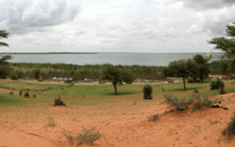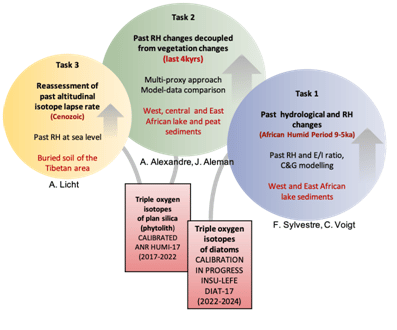ANR PAST-17
To assess the interactions between land surface (vegetation, water) and climate, relative humidity is a key parameter.
The PAST-17 project aims to take advantage of the recent development of triple oxygen isotope composition (17O-excess) analysis of biogenic silica to quantify past relative humidity and investigate three key issues concerning hydro-climates:
The 17O-excess of fossil phytoliths from Cenozoic palaeosols will be used to estimate past relative humidity and reassess the isotopic gradients used to reconstruct the topography of the Tibet-Himalaya orogen, a major component of the Earth's climate.
In a combined data/hydro-isotopic model approach, the 17O-excess of fossil diatoms will make it possible to reconstruct the hydrological balances of Sahelian and Saharan lakes during the African wet period (Green Sahara period between 9-5ka) more accurately than with the d-excess and δ18O alone. The climate of this period can serve as a reference for the climate forecast in the near future for certain parts of the Sahara and the Sahel.
As part of a multi-proxy approach, the 17O-excess of fossil phytoliths will be used to estimate past relative humidity and specify how the feedback loops between vegetation and climate were triggered in West, Central and East Africa between 3 and 1.5 ka, the period of the Iron Age and agricultural innovations.
The relative humidity data produced in the PAST-17 project will be made available for the improvement of Earth system models that poorly predict relative humidity variations in the intertropical zone.
The project relies on a consortium of specialists in 17O-excess water and minerals, climate, vegetation and lake water proxies, climate and vegetation models from CEREGE.
2023-2027: ANR PAST-17
Quantitative reconstruction of past hydroclimates: the triple oxygen isotopic composition (17O-excess) of biogenic silica in perspective
At CEREGE:
Responsible for: Anne Alexandre,
Participants: Julie Aleman, Florence Sylvestre, Alexis Licht Corinne Sonzogni, Jean-Charles Mazur, Christine Vallet-Coulomb, Françoise Chalié, Yannick Garcin, Guillaume Leduc, Pierre-Etienne Mathé, Pierre Deschamps, David Au Yang, Charlotte Mention.
Partner Institutes :
CEREGE, ISEM, EspaceDEV, HSM, LSCE
Foreign collaborators:
University of N'Djamena, Geo-resources and Reservoir Dpt (Chad), University of Abomey-Calavi (Benin), University of Dar-es-Salaam (Tanzania), UCAD and CRZ (Senegal).



